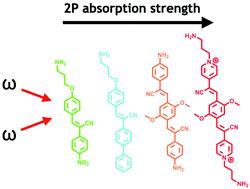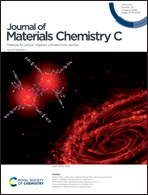Computational design of two-photon active organic molecules for infrared responsive materials†
Abstract
In this study we report theoretical studies of the linear and nonlinear optical properties of a series of π-conjugated organic cations and their neutral precursors which show π-stacking to exhibit aggregation-enhanced optical properties. These organic cations show promise as photoactive layers in hybrid quasi-2D perovskites for applications in optoelectronics, particularly in the short wavelength infrared region. We analyze the one- and two-photon (2P) absorption (2PA) transition strengths of several excited states in the considered systems at the coupled-cluster level theory employing the CC2 model. Furthermore, a microscopic insight into their 2P activity has been obtained using the generalized few-state model (GFSM). Based on our GFSM results, we pinpoint the origin of the desired nonlinear optical properties and provide a design strategy for efficient IR photoactive organic materials with potential application in organic–inorganic hybrid quasi-2D perovskites.



 Please wait while we load your content...
Please wait while we load your content...